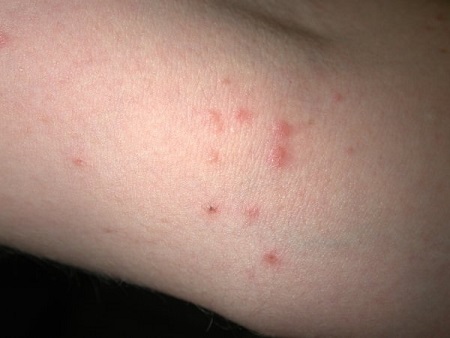Cheyletiella dermatitis in humans, dogs and cats

Commonly caused by Cheyletiellosis (Walking Dandruff) In cats and dogs
British Journal of Dermatology, Volume 143, Issue 5, 1 November 2000, Pages 1110–1112, https://doi.org/10.1046/j.1365-2133.2000.03869.x
Extract
SIR, In animals, Cheyletiella dermatitis (walking dandruff) is usually a highly contagious but mild, non‐suppurative (i.e. No pus) mite‐induced dermatitis produced by Cheyletiella spp. These parasites live on the skin of cats, dogs, rabbits and humans.1 The non‐burrowing mites live in the keratin layer of the epidermis and feed on surface debris and tissue fluids.2 Their ova are smaller than louse nits and are attached to hairs by fine fibrillar strands.1,3 The egg–larval–nymphal–adult stages are completed within 21 days on one host.4 Adult females may live free of their host for up to 10 days. Eggs that are shed with the animals’ hair into the environment are important sources of reinfestation. Humans may serve as an accidental or transitory host.3 The prevalence may be underestimated because of false‐negative samples.1
Case 1. A 14‐year‐old male, castrated black Persian cat was brought to the Dermatology Service of our clinic at the Veterinary University, Vienna, Austria because of dry white flakes and crusts over the dorsum without pruritus. Five months previously, a new kitten had been introduced to the household. The problem started a few days later; in addition, the owner developed pruritic (i.e. itchy) red spots on the chest and abdomen. Examination of the cat demonstrated seborrhoea sicca and miliary dermatitis over the dorsum. Although no Cheyletiella mites were found with acetate tape impressions, a diagnostic therapy trial was performed. After treatment of both cats with 0·2 mg kg−1 ivermectin orally on three occasions at 8‐day intervals they appeared clinically normal. The lesions of the owner disappeared without treatment.
Clinical features
Irregularly distributed, sometimes also grouped, urticarial or maculopapular, rarely vesicular, strongly itchy efflorescences at contact points. Significant increase in itching with bed heat.
In Clinical Veterinary Advisor: Birds and Exotic Pets, 2013
Physical Findings in Infected Humans
Cheyletiella infestation in humans usually will cause a mildly pruritic (itchy) dermatitis on the abdomen, chest, arms, legs, and buttocks. Small urticarial papules and vesicles may develop into an erythematous rash or into yellow crusted lesions that can be intensely pruritic. An area of central necrosis is often noted. Rare bullous eruptions and systemic reactions have been reported, especially in people with concurrent autoimmune disease.
Carlos Nicolas Prieto-Granada, … Martin C. MihmJr., in Diagnostic Pathology of Infectious Disease, 2010
A common cause of the so-called walking dandruff of dogs, rabbits, and cats, Cheyletiella spp. can also cause intensely pruritic dermatitis in humans. The disease manifests as erythematous papules and papulovesicles, which appear in areas where there is close contact with infested pets.961-964 These mites are non-burrowing and have a “bite and run” behavior.965 Lesions in humans probably result from delayed hypersensitivity reaction.966 The mites are not found in humans, and the diagnosis is confirmed on examination of the pets.963
There is usually a superficial dermal and mid-dermal lymphoeosinophilic infiltrate with some histiocytes. In the epidermis, prominent spongiotic change is identified at the site of the bite.
Identifying Characteristics and Disease Transmission
Cheyletiella are nonburrowing mites characterized by hooklike anterior palps (Figure 1) that have a worldwide distribution. Human dermatitis is the result of contact with an affected animal and may present as papular or bullous lesions. Cheyletiella blakei affects cats, Cheyletiella parasitovorax is found on rabbits, and Cheyletiella yasguri is found on dogs. The mites live in the outer layer of the epidermis of the host animal and feed on surface debris and tissue fluids.1 They complete an entire 35-day life cycle on a single animal host. The larval, nymph, and adult male mites die within 48 hours of separation from a host. The female mite and possibly the eggs can live up to 10 days off the host, which makes environmental decontamination a critical part of pest control.2 In animals, the mite often produces a subtle dermatitis sometimes called walking dandruff (Figure 2).3 Affected animals also can be asymptomatic, and up to 50% of rabbits in commercial colonies may harbor Cheyletiella or other mites.4












